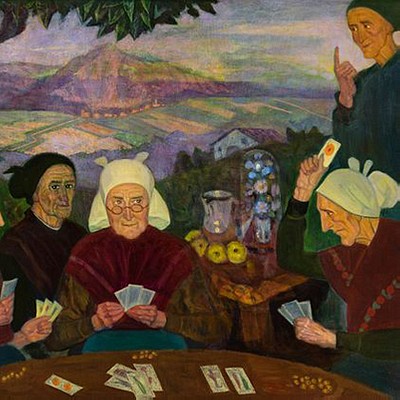FRANCISCO HERNÁNDEZ MONJO (Mahón, Menorca, 1862 - Barcelona, 1937). "Marina". Oil on canvas.
Lot 112
About Seller
Setdart Auction House
Carrer Aragó 346
Barcelona
Spain
Setdart Subastas was born in 2004 and is currently the first online art auction in Spain with solidity, prestige and reliability guaranteed by our more than 60,000 users. Setdart has a young, dynamic and enterprising team ready to successfully manage the purchase and sale of art works through custom...Read more
Estimate:
EUR€5,000 - EUR€6,000
$5,376.34 - $6,451.61
Absentee vs Live bid
Two ways to bid:
- Leave a max absentee bid and the platform will bid on your behalf up to your maximum bid during the live auction.
- Bid live during the auction and your bids will be submitted real-time to the auctioneer.
Bid Increments
| Price | Bid Increment |
|---|---|
| EUR€0 | EUR€10 |
| EUR€200 | EUR€25 |
| EUR€500 | EUR€50 |
| EUR€1,000 | EUR€100 |
| EUR€3,000 | EUR€200 |
| EUR€5,000 | EUR€500 |
| EUR€10,000 | EUR€1,000 |
| EUR€20,000 | EUR€2,000 |
| EUR€50,000 | EUR€5,000 |
About Auction
By Setdart Auction House
Dec 14, 2021
Set Reminder
2021-12-14 08:00:00
2021-12-14 08:00:00
America/New_York
Bidsquare
Bidsquare : 19th & 20th Century Fine Art
https://www.bidsquare.com/auctions/setdart-auction-house/19th-20th-century-fine-art-7992
Gaudi, Sorolla, Torres Garcia, Maclet, TSUGUHARU FOUJITA, Benjamin Palencia Setdart Auction House sofia@setdart.com
Gaudi, Sorolla, Torres Garcia, Maclet, TSUGUHARU FOUJITA, Benjamin Palencia Setdart Auction House sofia@setdart.com
- Lot Description
FRANCISCO HERNÁNDEZ MONJO (Mahón, Menorca, 1862 - Barcelona, 1937). "Marina". Oil on canvas. Signed in the lower right corner. Measurements: 70 x 126 cm; 91 x 147 cm (frame). In this work the author places us in front of a marina with two boats, one of them full of fishermen desperately trying to right the ship. The characters are threatened by moving waves, dark and transparent waters at the same time, worked with a great virtuosity. Beyond we see a high horizon on which we can guess the sky, which is united to the sea by the tonality and humidity of the atmosphere. The scene stands out for the great dynamism and expressiveness achieved by the author through the waves and the attitudes adopted by the protagonists of the painting. An outstanding sailor, specialized in painting ships, Hernández Monjó was the main renovator of the marine genre in the Balearic Islands at the end of the 19th century. Born into a family of silversmiths, from a very young age he dedicated himself to drawing the ports and ships of Mahón. At the age of twenty-three he was already teaching art in Mahón, where he had numerous disciples. In 1890 he settled in Barcelona, where he completed his training at the School of Fine Arts with Eliseo Meifrén. That same year he took part in the National Exhibition of Madrid. He also participated in the General Exhibitions of Barcelona in 1894 and 1920, and in 1936 in the I Saló d'Independents. He also held exhibitions in South America, where his work was very well received. In 1898, the Tasso house of Barcelona commissioned him a collection of watercolors of warships for the book "La Armada Española". He exhibited in Mahón, Madrid, Barcelona and South America, always being well received by the public and critics. In a first stage, his work can be framed within the realist painting of the second half of the 19th century. Drawing predominates over color, the brushstroke is flat and not very impastoed, and the chromatic range is soft and uniform, dominating the blues, greens and whites. They are often works of low horizon, with the sky occupying most of the painting. In 1890, with his change of residence, a new stage in his painting began, characterized by the influence of Catalan landscape painters, especially Meifrén. Hernández Monjó introduces new elements such as the diagonal composition, where the choppy sea, the boats with sails extended and the contrasting sky are the main motifs. The brushstroke becomes denser, firmer and shorter, and warmer tones such as pinks and reds are introduced in his palette. The last stage of his work, from 1920 onwards, is characterized by a luminous exaltation of impressionist roots and by a more impastoed brushstroke, with vivid tones, resulting in compositions of enormous strength. The subject matter expands, including views of the Catalan coast and its surroundings. Hernández Monjó is mainly represented in private collections, although he also has works in the Museum of Menorca, the Ateneo de Mahón, the Nautical School of Barcelona and the Museu de les Drassanes in Barcelona.
- Shipping Info
-
In-house shipping available. Please inquire at admin@setdart.com.
-
- Buyer's Premium



 EUR
EUR CAD
CAD AUD
AUD GBP
GBP MXN
MXN HKD
HKD CNY
CNY MYR
MYR SEK
SEK SGD
SGD CHF
CHF THB
THB

















